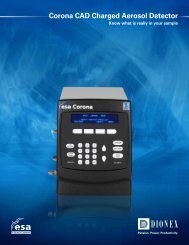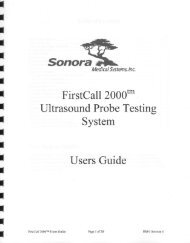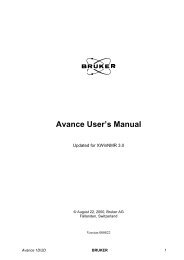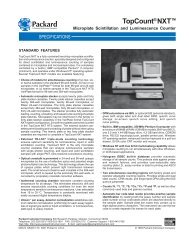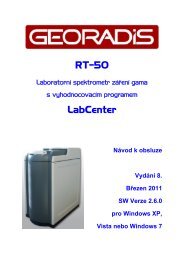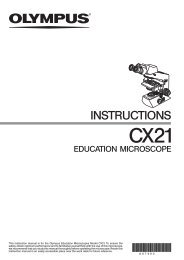HR-33T Dew Point Microvoltmeter Instruction/Service Manual ...
HR-33T Dew Point Microvoltmeter Instruction/Service Manual ...
HR-33T Dew Point Microvoltmeter Instruction/Service Manual ...
You also want an ePaper? Increase the reach of your titles
YUMPU automatically turns print PDFs into web optimized ePapers that Google loves.
where R is the electrical resistance of the junction and thermocouple lead wires in the immediate vicinity of thejunction. The second, or heating, term of the equation is negligible at small values of I, but because the heatingeffect increases with the square of I, it rapidly becomes the dominant factor in the equation. Thus, in thermocouplepsychrometers, there is an optimum value of cooling current that will produce maximum temperature depression,beyond which a further increase in current will actually reduce the cooling effect. Furthermore, microscopicdifferences in the geometry and alloy makeup of the junctions influence the value of R and hence the net coolingeffect. Thus, while the thermocouple voltage - temperature sensitivity, P ab , and the Peltier Coefficient, A ab , willbe identical in every junction made from the same two materials, the maximum cooling capability of a junctionwill vary somewhat from one junction to the next.When the temperature of the junction is depressed by means of Peltier cooling, heat will begin to flow into it fromits surroundings. This transfer of energy will limit the maximum realizable temperature depression, dependingupon numerous factors including chamber geometry, volume, and materials. When these factors are fixed,however, the maximum realizable temperature depression of the junction is also fixed. This maximumtemperature depression is of concern in thermocouple psychrometry, and of particular interest where the dew pointmethod is used.From the foregoing, it is clear that the Peltier Coefficient, A ab , does not, by itself, determine the maximumtemperature depression of the junction. For our purposes, therefore, we shall define a slightly different coefficientwhich we shall call the cooling coefficient. It shall be a characteristic parameter of a given thermocouplepsychrometer, representing its maximum junction temperature depression resulting from the passage of anominally optimum cooling current. Since the temperature of the junction is directly related to its thermoelectrice.m.f., the cooling coefficient will be expressed in microvolts (this is in harmony with the Peltier Coefficientwhich, as defined above, also has units of Watts-Ampere, or Volts).DEFINITION: The cooling coefficient A v , for a given thermocouple psychrometer is defined as thedifferential e.m.f. in microvolts that results from the passage of a specified nominally optimum coolingcurrent through the junction at a specified ambient temperature.Stated mathematically: A v = P ab )T m (5)where )T m is the temperature differential that results from the given current. The measurement of A v must beperformed in such a way that the differential e.m.f. is measured immediately after cessation of cooling currentflow, and is completely independent of any consequential effects of the current other than the temperaturedepression of the junction. These requirements are fulfilled in the <strong>HR</strong>-<strong>33T</strong>.Statistical data on a large number of Wescor Thermocouple Psychrometers have shown that the optimum coolingcurrent is typically 8.0 milliamperes. This value of cooling current is standard in the <strong>HR</strong>-<strong>33T</strong> <strong>Dew</strong> <strong>Point</strong><strong>Microvoltmeter</strong> (RMS current = 8 mA at 95% duty cycle).18







